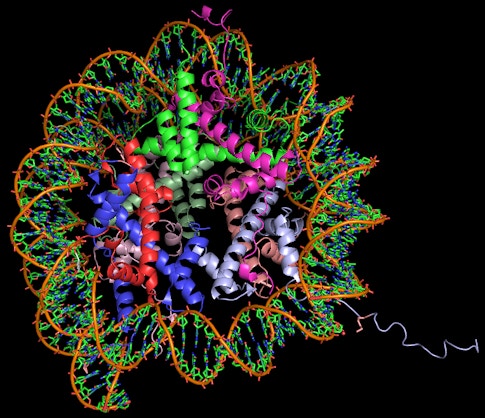The Genetic Riddle Wrapped in a Chromatin Mystery

Biochemist Takashi Onikubo has been interested in proteins for as long as he can remember — a fascination he connects to a childhood spent split between two countries. Born in Japan, Onikubo was raised in the United States until age 8, when his family returned to Osaka. “A sense of humor is really important in that region — even after a tragic experience, people will try to squeeze a laugh out of it,” he says. “My parents would behave differently there than they did in New York, and I started to wonder: Where is this difference coming from? Around that time I also learned that whatever we do as organisms is controlled by cells, and that proteins are the workhorses in every cell that make them do what they do.”
“I think my start as a scientist was right there,” he continues. “I wanted to learn all about proteins so that I could understand why the people around me were acting differently in different situations.”
Every cell needs certain proteins to carry out its business, and all cells build their proteins via a process known as transcription: Genetic information encoded within DNA gets copied onto RNA molecules, which then get carried to ribosomes within the cell where protein assembly takes place. But many details of how transcription occurs — including how the physical shapes of the biomolecules affect the process — still remain mysterious, and Onikubo has dedicated his research career to understanding them. An edited version of my interview with him follows.
Your interest in gene transcription has led you to study a substance in cells called chromatin. What is it?
Chromatin is the actual physiological form of the genetic element inside a cell. DNA is a very long molecule, and it is wrapped around proteins called histones. These together, called the nucleosomes, constitute the fundamental repeating unit of chromatin.
If chromatin is the physical “package” for our genetic information, what does it have to do with gene transcription?
Well, transcription is a fundamental process in which cells become equipped with whatever they need to serve their functions. And the physical organization or shape of the chromatin can regulate transcription, by masking the DNA sequences and serving as a physical barrier to aberrant factors. So, the first thing that occurs during transcription is a modification of the shape of the chromatin into one that makes the DNA sequences involved in transcription accessible.

So you’re studying how the literal physical shape of our chromatin affects which genes get expressed and, therefore, what proteins get made or not made?
Yes. It’s really a riddle, because sometimes those DNA sequences that regulate transcription are actually found at great distances from the location on the DNA molecule where the gene is actually transcribed. There’s lots of evidence that these two parts of the DNA molecule must form a three-dimensional configuration — a physical loop in the chromatin — before the functional interactions necessary for transcription can start. But exactly how those interactions are actually established is a very important question — and that’s what I’m attacking right now.
Why is this question about chromatin’s shape and gene transcription important?
When you say that a certain gene is important to the health of a person, that’s not actually different from talking about how the protein coded for by that gene is made, how well it’s made and how fast it can work. This becomes really important when it comes to diseases like cancer. One way of categorizing cancer is as a disease in which the genes for replication are aberrantly turned on — so it becomes important to know how those genes are turned on.
There’s good evidence that the chromatin is taking a form that allows the transcription of that “replication” gene to proceed aberrantly. So I think studying this process provides another layer of knowledge that feeds into the understanding and treatment of cancer.
Is there an open question in your domain that you hope will be answered during the course of your lifetime?
How cells behave in a tissue and in a whole organism, compared with how they behave individually, is something that I’d really like to know. There are many examples where a protein is involved in an essential function in a cell and yet disrupting that protein has very mild effects on the cell. This likely reflects the fact that multiple layers of regulation and redundancy in protein functions exist inside cells. I’d like to know if similar redundant and compensatory functions exist on the cellular level within a tissue. Interesting questions would be whether all cells in a tissue behave the same way and whether they make the same transcripts at the same level and at all times. I think these types of questions are now approachable and will become very important to truly understanding how cells work and how diseases arise.


